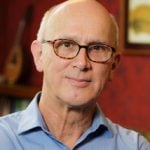
A few months ago my wife and I spent two weeks in England. She had several must-visit places on her list, and I had several on mine. Hers included Fortnum & Mason, where she loaded up on her favorite teas, and mine included three historical sites, one visited by many people and two visited only by a few. The site visited by many was Hadrian’s Wall, which cuts across northern England and which once kept the Picts from interfering with Rome’s attempt to colonize Britain. Much of the wall remains. From where I stood atop it, at Housesteads Fort, you could see it undulating over miles and miles of hills. Many people hike the length of the wall—84 miles—from Newcastle to Carlisle. I was half-tempted to join them and some day may.
The infrequently visited places on my list were associated with Samuel Johnson (1709-1784): his birthplace in Lichfield, a town north of Birmingham, and his house in Gough Square in London. The latter was where he worked on the Dictionary of the English Language that made him famous. In the garret, he and his amanuenses stitched together not just thousands of definitions but more than 100,000 illustrative quotations. Johnson selected the quotations from books that he marked up. He mined deeply the famous authors—Shakespeare, Milton, Spenser, Pope, Hooker, Dryden, Addison, Bacon, Swift, Locke—but also many whose names today are forgotten.
The dictionary took nine years. Looking at the two giant volumes, which I have in a facsimile edition, I marvel that one man could accomplish such a thing at all, let alone in nine years. (As Johnson happily noted before he began his project, the French equivalent had taken 40 scholars 40 years.)
Throughout the years he worked on his dictionary—he worked on other projects simultaneously—and really until the end of his life, Johnson was a maker of to-do lists. Each day he wrote out what needed to be done, and each subsequent day he wrote out an almost identical list. He complained that he never seemed to make progress, either with his writing projects or with his spiritual life. I can sympathize. When a friend was in town recently, I groused to him that I am years behind on my serious writing, and each month I grouse to my spiritual director that I am far behind on my spiritual development. Like Johnson, I too make to-do lists. Like him, tomorrow’s list will look almost the same as today’s. For that matter, the list for a month from today will look distressingly like today’s. Unlike Johnson, I do not suffer from melancholy, so I can set my persistent disappointments aside. His discouragement in never seeming to make progress must have been profound.
There is an irony in this, of course, since the shelves devoted to his works prove that he was a prolific writer, and the content of those works proves that he was a serious and, so far as I can tell, spiritually successful Christian, even though he did not have the advantages that a Catholic has, such as all seven sacraments.
To many people, myself included, Samuel Johnson is the premier English intellectual figure of the 18th century, and John Henry Newman is that of the 19th. At home I have almost all of Johnson’s works and almost all of Newman’s. Newman’s style is less corrugated than Johnson’s and so is more attractive to readers of our time. Newman, who likely will be beatified soon, had a well-oiled spiritual life. He wrote directly on theology, while Johnson wrote on things more removed from my vocational interests. Newman had few quirks; Johnson had many.
In many ways Newman is the more attractive character, whether in terms of personal deportment or literary style or topics addressed. Despite that, often I feel more of an affinity with Johnson than with Newman. I am not sure why, but this may speak to the elemental power of uncompleted to-do lists.


